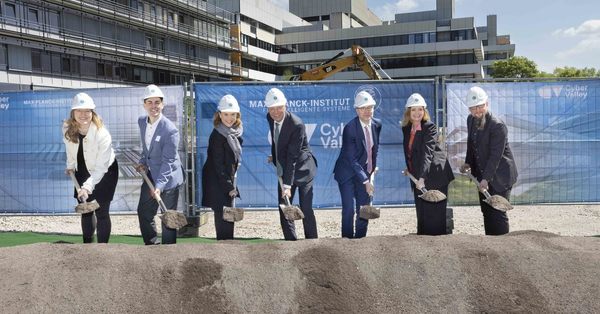Simulation science at the top
Interview with the SimTech Cluster spokespersons

An article from the university of Stuttgart, Interview: Lydia Lehmann. To the original text
The halfway point of the funding period for the University of Stuttgart’s Data-integrated Simulation Science Cluster of Excellence was recently reached. What have you achieved so far?
Prof. Wolfgang Nowak: Conventional simulation technology involves the numerical simulation of physical principles on computers. Huge amounts of experimental data have recently become available that can improve such simulations. This is why we had set ourselves the goal of bringing about a paradigm shift away from traditional simulation technology towards "data-integrated simulation science"...
Prof. Thomas Ertl: ...yes, we incorporated data science and machine learning with a view to merging simulation science and data science to establish a more advanced simulation discipline.
Nowak: That was a really radical change and what we now know is that this paradigm shift has played a central role in all of the 80 projects we have successfully completed during the first half of the project. Comments from our researchers, such as: “I am among the foremost researchers doing data-integrated simulation science in my field”, which we hear again and again, show that it has been successful both at the collective and personal levels.
Ertl: The heterogeneity and breadth of SimTech's research successes can be seen in all seven project networks; focusing on individual ones is almost pointless. All in all, simulation science has coalesced and matured over the past 15 years from isolated approaches into an independent discipline.
We run our own SimTech bachelor's and master's study programs, host our own graduate school where more than 200 people have earned doctorates in simulation science, and are proud to have ten post-doctoral habilitations in simulation science. There is a funding structure in place for post-doc projects, and we have established seven junior research groups: we have been joined by four men and three women, mostly from outside the university, who are now leading their research groups with great success. We also announced six new professorships, all of which have since been taken up by excellent researchers. The fact that SimTech is an internationally established trademark of the University of Stuttgart is a unique selling point.
Director of the Stuttgart Centre for Simulation Science and co-spokesperson of the Cluster of Excellence SimTech Prof. Ertl (left) with co-spokesperson Prof. Nowak. Photo: Jakob Dürrwächter, Daniel Kempf und Claus-Dieter Munz, Universität Stuttgart
What do you personally like most about SimTech?
Ertl: Even as a veteran of almost 20 years, what fascinates me is the level of collaboration and personal interaction – and the fact that we have been so successful on this basis. The development over the years of such an excellent culture of collaboration in a cluster of this size, which still leaves room for many idiosyncrasies and in which everyone is on an equal footing, is not something that can be taken for granted. I'm saying that now as the spokesperson, but this is the lived reality across all status groups.
Nowak: Yes – how did one of the reviewers put it during our last review? Ah yes: "This degree of team spirit cannot be faked."
Ertl: (laughs.) Yes, that was a phrase from someone from outside the group that sums it up nicely.
Prof. Steffen Staab: What always impresses me are our annual SimTech status meetings in Bad Boll, which are attended by around 200 active SimTech researchers. That's where you get a physical sense of the size of the undertaking as you walk the corridors and how enthusiastic everyone is about it.
Nowak: I like the interdisciplinarity on an equal footing and having our own SimTech vocabulary. As an environmental engineer and porous-media researcher, I stroll into the math building, and after enough discussions with mathematicians, I no longer feel out of my depth. Then I head over to the computer science building with new questions and experience the same thing. (laughs.) And I sit on the board of directors alongside a theoretical chemist, a systems biologist and others, where discussions also take place on various professional levels. I love that!
So SimTech is the living embodiment of the "Stuttgarter Weg" (Stuttgart way) of doing interdisciplinary research. And, in keeping with the University of Stuttgart's vision, why is your simulation research important for society and for the future?
Ertl: Simulations are run by people and don’t take place in a vacuum. We want to make simulations and the data they yield available for different application contexts – think "pervasive simulation and visualization": not only on a supercomputer or at a lab desk, but also for a geologist taking pictures on a tablet with built-in sensors outside in the real world, collecting data and feeding it directly into a simulation that then runs remotely on a supercomputer before feeding the results back to the user. The issues involved include the interfaces between supercomputers and mobile devices as well as more compact displays for tablets.
Nowak: The Digital Human Model is another example, where our researchers are working on personalized prognoses on a per-patient basis. A patient with a spinal disk injury is admitted to the hospital to have a prosthesis implanted. We need to quickly calculate the exact forces acting on the bones and spinal disk due to nerve stimuli, muscles, and tendons in this specific patient. A simulation can then be used to predict which implant would be the best.
Is this just a distant dream for the future, or are we on the verge of using such personalized spinal disk implants?
Nowak: We at SimTech are basic researchers; the systems we program are not immediately used in hospitals. There is one more technology transfer stage in between. However, we can already use real CT data to show that the necessary calculations can actually be done. And we can use augmented or virtual reality glasses to visualize the force conditions that occur during movements as well as which part of the muscle they affect and how.
Staab: There are several transfer-oriented application projects that are not funded by the Cluster of Excellence, but which build on SimTech's methodological innovations. For example, one project with the University Hospital of Jena is just getting underway, which involves simulating processes in the liver and simultaneously using machine learning to support the tumor board, in which doctors with expertise in various specialist areas consult with each other on the diagnosis and treatment of liver tumors. Incidentally, the industrial sector is already using SimTech's methodological findings as the result of transfer activities of this kind.
What will change at SimTech in the second half of the funding period? What would you like to focus on?
Ertl: I will be retiring in October. We started the SimTech generation change last year, since which time Wolfgang Nowak and Steffen Staab have been co-spokespersons for the cluster, my successor duo. Holger Steeb will be assuming the position of director at the Stuttgart Center for Simulation Science. With these three individuals, an excellent team is in place to prepare and hopefully lead SimTech's next application for excellence status to success.
Staab: We’re aiming for a combination of evolution and revolution. Whilst data-integrated simulation science does indeed represent a new paradigm, we will of course continue to think beyond it. To what extent will simulation science undergo a fundamental change? That's a challenge because there is only one simulation science, yet many contributing disciplines all with their own different vernaculars. I believe that achieving success here will enable us to make a considerable difference, because we will have an impact on various disciplines.
Nowak: The opportunity is already there to pick up on certain topics right now in order to redirect SimTech's focus for potential follow-up funding as a cluster of excellence. One such area of interest is our new "Quantum Computing for Simulation" project network, where we are working closely with theoretical chemists as well as theoretical and experimental physicists to make quantum computers fit for our simulation runs and to tune the algorithms accordingly.
Staab: The second thing we want to focus on is "Knowledge-Infused Simulation Science," or knowledge integration. We want to make simulation systems as intelligent as possible, for example by having them learn from experience or by incorporating expert knowledge into our simulations, which would save computing power and time.
Nowak: And we are aware of what the science-supporting structures have accomplished so far – for example, when it comes to promoting young scientists, internationalization, diversity, study programs, the management of scientific data, public relations, and reflecting on one's own work. We would like to continue our success and surpass what we have achieved so far.
About SimTech
From 2007 to 2018, there was the Cluster of Excellence 310 Simulation Technology at the University of Stuttgart, which was funded twice by the DFG. Since 2019, there has been the Cluster EXC 2075 Data-integrated Simulation Science, which is currently in its first funding phase and is now eligible to apply for a second funding phase, as part of the Excellence Strategy of the German federal and state governments. Both clusters are internationally established under the acronym SimTech. In addition to the clusters, there is the Stuttgart Centre for Simulation Science, a faculty-like institution at the University of Stuttgart that ensures the sustainability of simulation research independently of the clusters of excellence.
SimTech is not assigned to any faculty, but seven faculties are involved in SimTech. It is an independent profile area of the University of Stuttgart. In terms of subject matter, SimTech is a mixture of engineering sciences, related natural sciences up to theoretical chemistry as well as mathematics and computer science. The focus in the applications that SimTech serves is on engineering. The researchers work in a method-oriented manner. They research fundamental simulation methods that are universally applicable.
The interdisciplinarity and relevance of SimTech can be seen, for example, in the connections to the AI research consortium Cyber Valley, to the network European Laboratory for Learning and Intelligent Systems (ELLIS) or to the Stuttgart Research Focus Interchange Forum for Reflecting on Intelligent Systems (IRIS) at the University of Stuttgart.
Video
Related Articles

Funded Doctoral Positions at the International Max Planck...

Groundbreaking Ceremony for the Cyber Valley Building in ...




